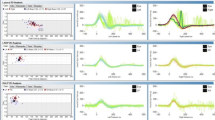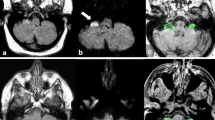Abstract
Background
Ocular motor and vestibular manifestations of Wernicke’s thiamine deficiency (WTD) are frequent and heterogeneous. Previous neuropathological and neuroimaging findings identified brainstem and cerebellar lesions responsible for these findings, however, peripheral vestibular lesions are probably uncommon in human WTD, though noted on an avian thiamine deficient study.
Material
Single case study of a WTD patient post-gastric bypass who developed ataxia, oscillopsia and nystagmus, with low serum thiamine, and increased MRI T2 signal in the thalami, but normal brainstem and cerebellum. Vestibular evaluation showed significant vestibular hyporreflexia affecting all six canals, and a chronic upbeat nystagmus, now for 14 months after WTD onset.
Methods
Serial clinical, video head impulse, nystagmus analysis, cervical and ocular vestibular evoked responses. She is undergoing treatment with Memantine, Clonazepam and vestibular rehabilitation, and feels improvement.
Conclusion
This report shows a novel combination of central and peripheral vestibular findings, of relevance for diagnosis and treatment, in addition to the development of a coherent hypothesis on the ocular motor and vestibular findings in WTD.







Similar content being viewed by others
Data availability
Data from clinical, vestibular recording, eye movement recordings and video recording are avialable upon request.
References
Gagnier JJ et al (2013) The CARE guidelines: consensus-based clinical case reporting guideline development. Glob Adv Health Med 2(5):38–43
Marti S, Palla A, Straumann D (2002) Gravity dependence of ocular drift in patients with cerebellar downbeat nystagmus. Ann Neurol 52(6):712–721
Kattah JC (2017) The spectrum of vestibular and ocular motor abnormalities in thiamine deficiency. Curr Neurol Neurosci Rep 17(5):1–9
Baloh RW (1996) Disorders of the vestibular system. Oxford University Press, New York
Leigh RJ, Zee DS (2015) The neurology of eye movements. Oxford University Press, Oxford
Pierrot-Deseilligny C, Milea D (2005) Vertical nystagmus: clinical facts and hypotheses. Brain 128(Pt 6):1237–1246
Dickman JD, Angelaki DE (2002) Vestibular convergence patterns in vestibular nuclei neurons of alert primates. J Neurophysiol 88(6):3518–3533
Kattah JC, McClelland C, Zee DS (2019) Vertical nystagmus in Wernicke’s encephalopathy: pathogenesis and role of central processing of information from the otoliths. J Neurol 266(Suppl 1):139–145
Kattah JC et al (2018) Conversion of upbeat to downbeat nystagmus in Wernicke encephalopathy. Neurology 91(17):790–796
Jorge A et al (2020) The use of video-head impulse test in different head positions in vertical nystagmus and ataxia associated with probable thiamine deficiency. Cerebellum 19(4):611–615
Furman JM, Cass SP (1999) Benign paroxysmal positional vertigo. N Engl J Med 341(21):1590–1596
Kim JS, Zee DS (2014) Clinical practice. Benign paroxysmal positional vertigo. N Engl J Med 370(12):1138–1147
Choi JY, Kim JS (2019) Central positional nystagmus: characteristics and model-based explanations. Prog Brain Res 249:211–225
Helmchen C et al (2022) Downbeat nystagmus is abolished by alcohol in nonalcoholic wernicke encephalopathy. Neurol Clin Pract 12(5):e129–e132
Victor M, Adams RD, Collins GH (1971) The Wernicke’s–Korsakoff syndrome. Davis Company, Philadelphia
Swank RL, Pardos M (1942) Avian thaimine deficiency. II. Pathologic cahnges in the brain and cranial nerves. (Especially the Vestibular) and their relation to the Clinical Behavior. Arch Neurol Psychiatry 47(1):97–131
Kattah JC et al (2013) Vestibular signs of thiamine deficiency during the early phase of suspected Wernicke encephalopathy. Neurol Clin Pract 3(6):460–468
Lee SH et al (2018) Vestibular dysfunction in Wernicke’s encephalopathy: predominant impairment of the horizontal semicircular canals. Front Neurol 9:141
Author information
Authors and Affiliations
Corresponding author
Supplementary Information
Below is the link to the electronic supplementary material.
Supplementary file1 (MP4 36093 KB)
Rights and permissions
Springer Nature or its licensor (e.g. a society or other partner) holds exclusive rights to this article under a publishing agreement with the author(s) or other rightsholder(s); author self-archiving of the accepted manuscript version of this article is solely governed by the terms of such publishing agreement and applicable law.
About this article
Cite this article
Zhu, W., Steenerson, K.K. & Kattah, J.C. Generalized vestibular hyporeflexia and chronic upbeat nystagmus due to thiamine deficiency. J Neurol 270, 1713–1720 (2023). https://doi.org/10.1007/s00415-022-11514-z
Received:
Revised:
Accepted:
Published:
Issue Date:
DOI: https://doi.org/10.1007/s00415-022-11514-z




